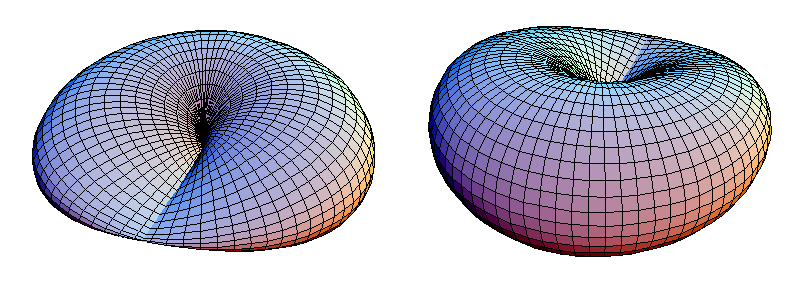Cross-cap
|
|
In mathematics, a cross-cap is a two-dimensional surface that is topologically equivalent to a Möbius strip. The term 'cross-cap', however, often implies that the surface has been deformed so that its boundary is an ordinary circle.
A cross-cap that has been closed up by gluing a disc to its boundary is called a real projective plane. Two cross-caps glued together at their boundaries form a Klein bottle. An important theorem of topology, the classification theorem for surfaces, states that all two-dimensional nonorientable manifolds are spheres with some number of 'handles' and at most two cross-caps.
Cross-cap model of the real projective plane
A cross-cap can also refer synonymously to the closed surface obtained by gluing a disk to a cross-cap. This surface can be represented parametrically by the following equations:
- <math> X(u,v) = r \, (1 + \cos v) \, \cos u, <math>
- <math> Y(u,v) = r \, (1 + \cos v) \, \sin u, <math>
- <math> Z(u,v) = - \hbox{tanh} \left( {2 \over 3} (u - \pi) \right) \, r \, \sin v,<math>
where both u and v range from 0 to 2π. These equations are similar to those of a torus. Figure 1 shows a closed cross-cap.

|
|
A cross-cap has a plane of symmetry which passes through its line segment of double points. In Figure 1 the cross-cap is seen from above its plane of symmetry z = 0, but it would look the same if seen from below.
A cross-cap can be sliced open along its plane of symmetry, while making sure not to cut along any of its double points. The result is shown in Figure 2.

|
|
Once this exception is made, it will be seen that the sliced cross-cap is homeomorphic to a self-intersecting disk, as shown in Figure 3.
| Missing image SelfIntersectingDisk.PNG Image:SelfIntersectingDisk.PNG |
|
The self-intersecting disk is homeomorphic to an ordinary disk. The parametric equations of the self-intersecting disk are:
- <math> X(u,v) = r \, v \, \cos 2 u, <math>
- <math> Y(u,v) = r \, v \, \sin 2 u, <math>
- <math> Z(u,v) = r \, v \, \cos u, <math>
where u ranges from 0 to 2π and v ranges from 0 to 1.
Projecting the self-intersecting disk onto the plane of symmetry (z = 0 in the parametrization given earlier) which passes only through the double points, the result is an ordinary disk which repeats itself (doubles up on itself).
The plane z = 0 cuts the self-intersecting disk into a pair of disks which are mirror reflections of each other. The disks have centers at the origin.
Now consider the rims of the disks (with v = 1). The points on the rim of the self-intersecting disk come in pairs which are reflections of each other with respect to the plane z = 0.
A cross-cap is formed by identifying these pairs of points, making them equivalent to each other. This means that a point with parameters (u,1) and coordinates <math> (r \, \cos 2 u, r \, \sin 2 u, r \, \cos u) <math> is identified with the point (u + π,1) whose coordinates are <math> (r \, \cos 2 u, r \, \sin 2 u, - r \, \cos u) <math>. But this means that pairs of opposite points on the rim of the (equivalent) ordinary disk are identified with each other; this is how a real projective plane is formed out of a disk. Therefore the surface shown in Figure 1 (cross-cap with disk) is topologically equivalent to the real projective plane, RP2.
See also: Boy's surface, Roman surface.
